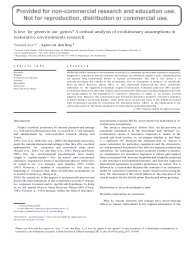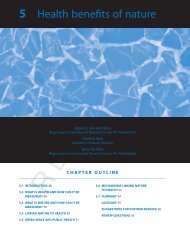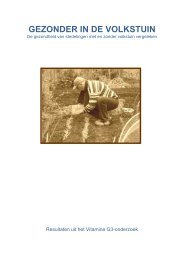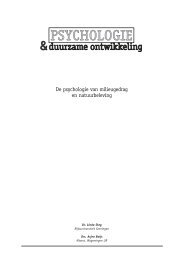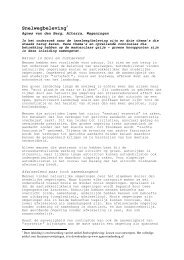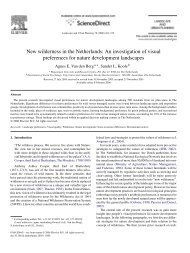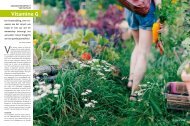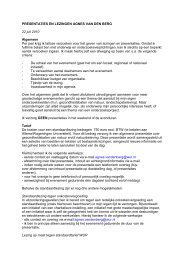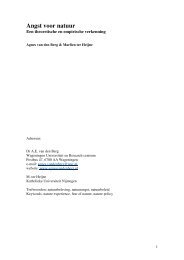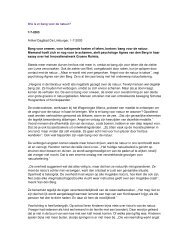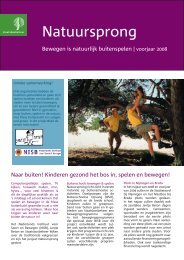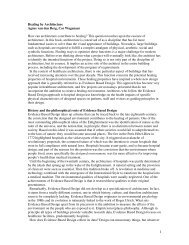healing environments in radiotherapy - Agnes van den Berg
healing environments in radiotherapy - Agnes van den Berg
healing environments in radiotherapy - Agnes van den Berg
You also want an ePaper? Increase the reach of your titles
YUMPU automatically turns print PDFs into web optimized ePapers that Google loves.
Heal<strong>in</strong>g Environments <strong>in</strong> Radiotherapy Project Report<br />
Comparative Case Study<br />
Because <strong>heal<strong>in</strong>g</strong> <strong>environments</strong> <strong>in</strong> <strong>radiotherapy</strong> are <strong>in</strong>tended to provide a number of benefits to<br />
cancer patients, it was deemed important to ga<strong>in</strong> the patients’ perspective on the k<strong>in</strong>d of elements<br />
of <strong>radiotherapy</strong> <strong>environments</strong> that are needed to create a <strong>heal<strong>in</strong>g</strong> environment. This k<strong>in</strong>d of<br />
qualitative data is essential especially <strong>in</strong> under-researched areas, s<strong>in</strong>ce it can provide important<br />
directives for the practical implementation of theoretical f<strong>in</strong>d<strong>in</strong>gs, as well as guide future research<br />
efforts.<br />
Both cancer patients and <strong>radiotherapy</strong> staff can be expected to have valuable <strong>in</strong>sights <strong>in</strong>to which<br />
elements of <strong>heal<strong>in</strong>g</strong> <strong>environments</strong> ‘work’ for patients <strong>in</strong> terms of creat<strong>in</strong>g a sense of well-be<strong>in</strong>g,<br />
reduc<strong>in</strong>g stress, and support<strong>in</strong>g a positive and hopeful attitude. Therefore, the comparative case<br />
study addressed both the patient and the staff perspective on <strong>heal<strong>in</strong>g</strong> <strong>environments</strong> <strong>in</strong> <strong>radiotherapy</strong>.<br />
Here, it needs to be said that, although <strong>heal<strong>in</strong>g</strong> <strong>environments</strong> also have significant benefits for staff,<br />
the limited scope and timeframe of this project did not allow for a separate <strong>in</strong>vestigation of these<br />
benefits. Therefore, f<strong>in</strong>d<strong>in</strong>gs regard<strong>in</strong>g the benefits of <strong>heal<strong>in</strong>g</strong> <strong>environments</strong> for staff were only<br />
<strong>in</strong>cluded <strong>in</strong> the report if they provided <strong>in</strong>direct benefits for the patients.<br />
The patient perspective was <strong>in</strong>vestigated through focus groups, a k<strong>in</strong>d of semi-structured group<br />
<strong>in</strong>terview, at the <strong>radiotherapy</strong> departments of the target and control hospitals. This enabled the<br />
consultancy team to compare <strong>in</strong>sights from patient groups who had been exposed to different k<strong>in</strong>ds<br />
of <strong>radiotherapy</strong> environment. The perspective of <strong>radiotherapy</strong> staff was <strong>in</strong>vestigated through semistructured<br />
<strong>in</strong>terviews with <strong>in</strong> total six employees at the target and control hospital’s <strong>radiotherapy</strong><br />
departments. The detailed methodology of the focus groups and staff <strong>in</strong>terviews is outl<strong>in</strong>ed <strong>in</strong><br />
section 3 on patient and staff perspectives.<br />
1.6 Report structure<br />
The literature review uncovered several elements that are important <strong>in</strong> <strong>heal<strong>in</strong>g</strong> <strong>environments</strong>.<br />
Through the good practice research and expert <strong>in</strong>terviews, these f<strong>in</strong>d<strong>in</strong>gs could be substantiated and<br />
made applicable to the specific focus on cancer patients. In order to avoid repetition, this report<br />
presents the f<strong>in</strong>d<strong>in</strong>gs of the literature review, good practice research, and expert <strong>in</strong>terviews together<br />
<strong>in</strong> one section. The third section of the report will then focus on the f<strong>in</strong>d<strong>in</strong>gs of the comparative case<br />
study, highlight<strong>in</strong>g first the patient perspective on elements of <strong>heal<strong>in</strong>g</strong> <strong>environments</strong>, and then<br />
turn<strong>in</strong>g to the perspective of <strong>radiotherapy</strong> staff. The f<strong>in</strong>d<strong>in</strong>gs of the project are summarised <strong>in</strong> the<br />
penultimate section concerned with specific recommendations for <strong>heal<strong>in</strong>g</strong> <strong>environments</strong> <strong>in</strong><br />
<strong>radiotherapy</strong>. F<strong>in</strong>ally, the report discusses limitations of the approach taken <strong>in</strong> this project and<br />
directions for further research.<br />
10



